Selling an ecommerce business isn’t quite the same as selling a traditional brick and mortar company. In some ways, it’s much easier to sell an online store, and in other ways, there are additional challenges.
People decide to sell their ecommerce shop for various reasons.
Maybe you’ve reached a pivotal moment of growth where you’d need to invest and expand to continue running the shop on your own. Or perhaps you’ve wanted to sell from day one, and plan to flip more ecommerce websites with the profits from this sale.
Regardless of your reason, the process of selling an ecommerce business remains the same. Follow this guide to get the maximum possible value for your online store.
Find the Best Brokers
There are hundreds of business brokers in the USA! Find out which one is the best match for your specific needs. Enter your zip code below to begin.
Sell Your eCommerce Business for the Best Price in 10 Steps
Selling an online business can be overwhelming. But I’ve simplified this complex process into just ten simple steps.
This guide takes you through each stage of the selling process, from preparing for the sale through the transition once the sale is complete.
Step #1: Prepare Your Site for the Sale
Before we talk about any numbers, take a moment to put yourself in the shoes of a prospective buyer. The very first thing they’re going to do is visit your website.
You need to make sure that the site is appealing to new owners. If it has clutter, navigation issues, and a poor UX, buyers see this as extra work they need to do after the acquisition.
Think of your ecommerce website like a house. It’s much easier to sell a home that’s turnkey. The kitchen is updated. The appliances are new. All of the plumbing and electrical are functioning properly. Will a new owner come in and paint some walls? Sure. But that won’t prevent them from buying.
The same analogy can be applied to your ecommerce site. Your website is more valuable to buyers if it doesn’t need lots of work on the back end.
In terms of site architecture, your products should never be more than two clicks away from the homepage.
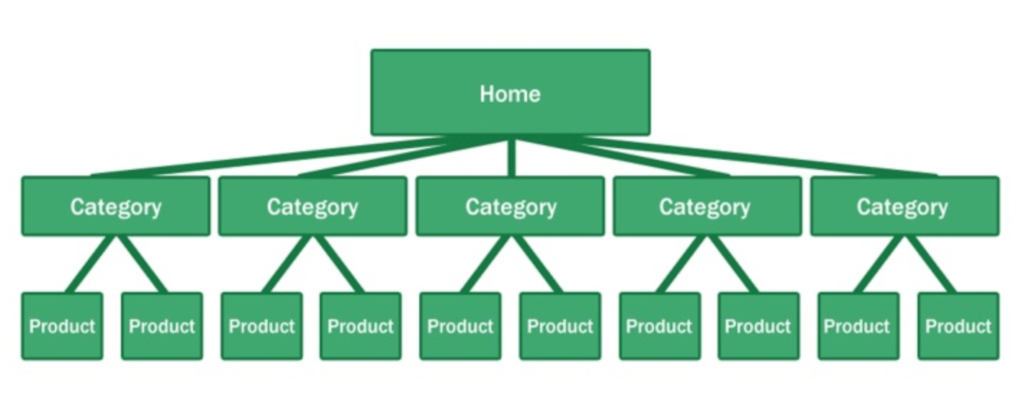
Update your theme. Clean up the design. Make sure the navigation is seamless.
But above all—keep it simple. If a new owner wants to update the logo, you don’t want it to clash with the theme.
Step #2: Update Your Inventory
It’s common for ecommerce websites to have products that go out of stock. This is something that I’m sure you’re familiar with.
While you want to make sure that you don’t neglect the business as you’re prepping for sale, you probably don’t need to pour tons of cash into new inventory. With that said, a website with products marked “out of stock” on nearly every page will be unappealing to your customers and prospective owners.
If you end up removing lots of products from the site, you should also condense your product categories, so it makes sense for the new owner. Having 20 or 30 categories can be overwhelming for someone to take on. But five or ten is much easier to manage.
Update and optimize the product images for items that are still active. Make sure the descriptions are clean and accurate as well.
You could potentially run a sale on some of your old inventory as you’re cleaning things up. Not only will this help you get organized, but it’s also good for your sales metrics (we’ll discuss this in greater detail shortly).
Step #3: Organize Your Financials
You might be great at selling products online, but most entrepreneurs aren’t expert accountants or bookkeepers. Depending on the size and scope of your ecommerce site, you might be handling all of the financials on your own.
Maybe you’re doing this manually with a spreadsheet, or maybe you’re using small business accounting software, like QuickBooks.
If you’ve been managing your books by yourself so far, it’s time to bring on a professional before you can proceed with selling the online store.
You don’t need to hire a new employee. Just retain a third-party accountant or bookkeeper to help you out. In fact, accounting is the most common outsourced business process, according to a recent study by Clutch.
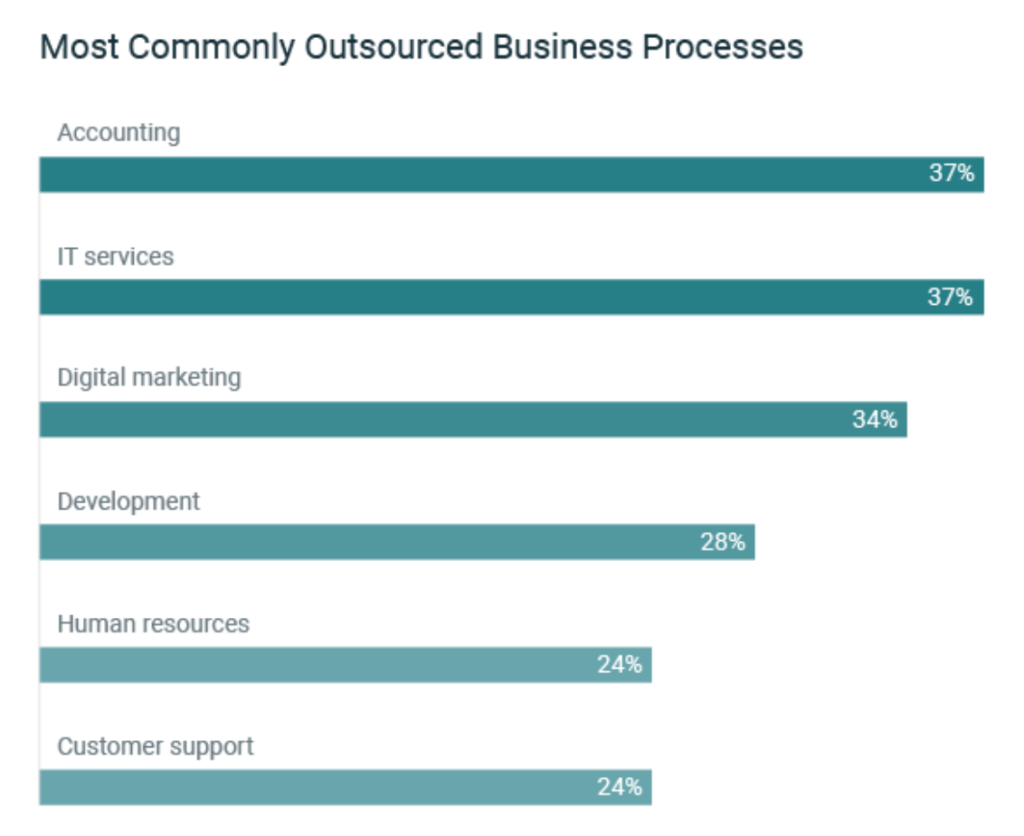
Lots of eyes will be on your company’s financials during the sales process. Prospective buyers, lawyers, accountants, appraisers, lenders, advisors, and plenty of other people will be going through your financial statements.
At a minimum, expect to have the following financials prepared:
- Last three years of tax returns
- Income statement
- Cash flow statement
- Balance sheet
Some buyers might request additional information as well.
Just one mistake in your financials can be a red flag for buyers. They could feel like you’re trying to deceive them or that your lack of accuracy and attention to detail is a problem in other areas of the business.
Clean and accurate financial statements are much more appealing to a prospective buyer.
Step #4: Organize Customer Data
While this isn’t quite as important as your company’s financials, your existing customer list is going to be extremely valuable to buyers. If you’re turning this over to the new owner, it’s a huge selling point, especially in the commerce space.
The new owner will likely want to start running marketing campaigns and promotions right away. It’s much easier to sell to existing customers and contacts within your ecommerce CRM.
So take the time to make sure all of this information is accurate, updated, and in order.
Remove duplicates. Get rid of inactive contacts. Make sure the customers are segmented properly.
When you put the site up for sale, potential buyers want to know about your customers. Here’s a listing in the Shopify Exchange Marketplace.
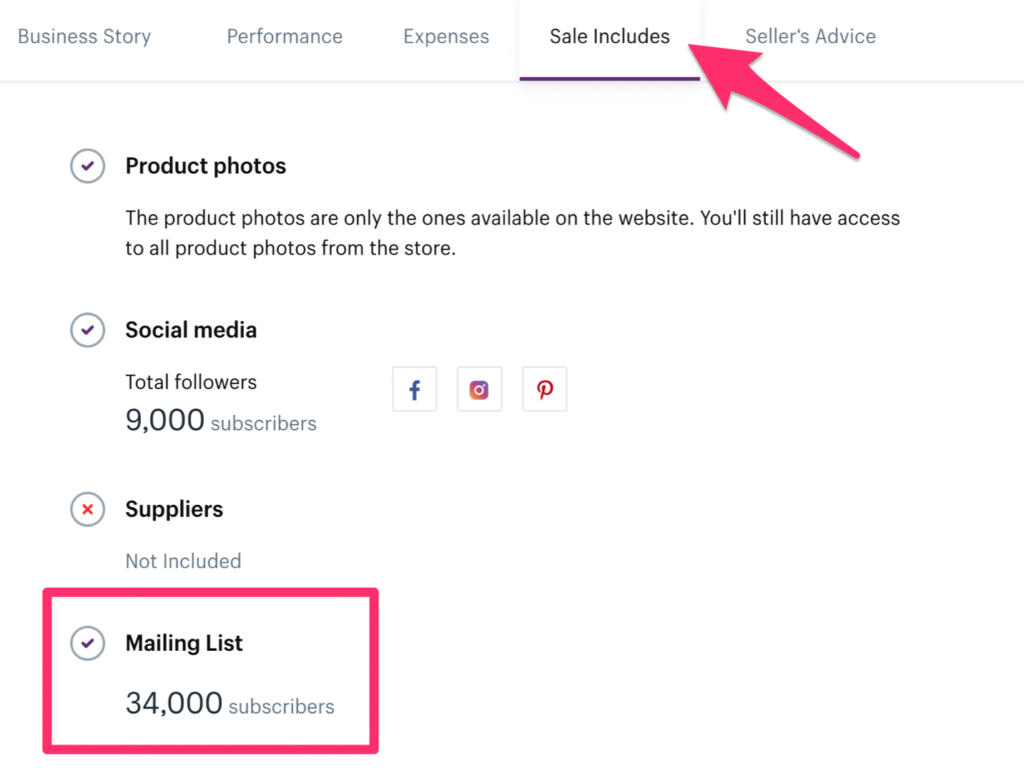
As you can see, the sale of this online store includes a list of 34,000 subscribers.
This won’t necessarily make or break the sale. You could have 100,000 subscribers, but it’s useless if the store isn’t generating income. But this is definitely a “nice-to-have” feature that will add value to the sales price fo your ecommerce shop.
Step #5: Focus on Sales and Traffic
The sale of an ecommerce business doesn’t happen overnight. Things take time.
Don’t let the idea of selling your business distract you from the company itself. As of right now, you’re still the owner. You stand to benefit from the profits, and it’s important to keep running things as usual.
Continue finding ways to boost your sales revenue. Keep driving traffic to your website.
These metrics will make the business more valuable to potential buyers.
If traffic drops or sales start to decline after you list the business for sale, it’s a red flag to new owners. Here’s another example from the Shopify Exchange Marketplace, showcasing the total revenue by month for a listing:
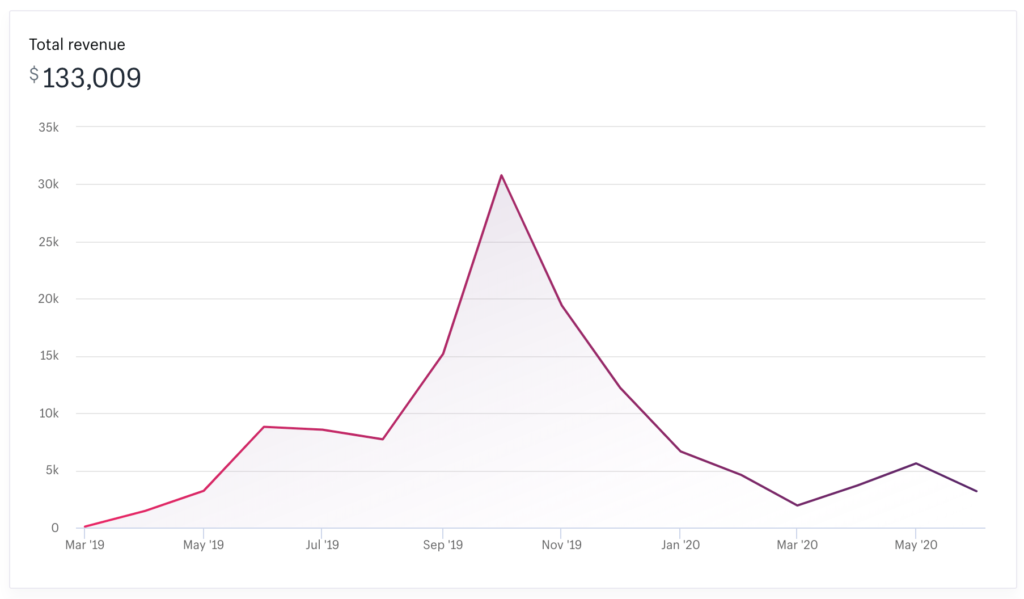
This type of trend line would be concerning for a prospective buyer. What caused such a sharp drop in sales?
You may not always be able to sell your ecommerce business at its peak, but you definitely won’t get maximum value for it on the decline.
If your sales metrics look like the graph above, you’re probably not ready to sell the company just yet. Get back to several months of an upward trend before you officially offer the site on the open market. Once it’s listed, continue focusing on sales until a deal has been finalized with a buyer.
Step #6: Consult With a Valuation Expert
How much is your ecommerce website worth? Lots of owners think they know the answer to this question, but they really have no idea.
You can’t just pull a number out of thin air. Otherwise, you’ll run the risk of listing the website too high or too low.
Instead, a third-party appraiser can give your ecommerce website a fair valuation. While this number may not be the final sale price, it will at least give you a ballpark estimate.
Some of the most common factors that attribute to the valuation of an ecommerce business include:
- Traffic
- Financials
- Age of business
- Customer service
- Logistics and fulfillment
- Inventory
- Supplier relationships
- Technology
- Intellectual property
- Patents and trademarks
Why is it so important to consult with a valuation expert?
The appraiser should provide you with a detailed report of how they landed on a particular number. This report can add credibility to your listing on the open market.
Furthermore, a proper valuation could help you get tens of thousands of dollars more than you expected for your business. For example, let’s say you assume your ecommerce website is worth $100k. You get a few offers in the $90k range and consider accepting. Good deal, right?
An appraiser might tell you that the business is actually worth $150k. All of a sudden, those $90k offers don’t seem so great. You could hold out and wait for a buyer to offer a better price. But you wouldn’t know to do this without the help of a professional valuation expert.
Step #7: Find an eCommerce Broker
There are lots of online platforms that you can use to sell your ecommerce business.
Find the Best Brokers
There are hundreds of business brokers in the USA! Find out which one is the best match for your specific needs. Enter your zip code below to begin.
If you’re using Shopify, it has an integrated exchange marketplace. But there are plenty of other reputable brokers to consider. Some of the top options include:
- Flippa – best for businesses with Under $300,000
- Digital Exits – best for businesses with over $300,000 to $10m in yearly profit
- HL.com – best for businesses with over $10m in yearly profit
It’s easy to get started, and they even have a free valuation tool. I’d still recommend using a valuation expert (described in step #6), but it’s nice to see if those numbers are in the same range.
A brokerage marketplace will probably be the cheapest way to sell your ecommerce business.
Finding an actual broker who can help speed up the process will cost you more in terms of commission fees. But you’ll likely be able to sell faster and for a higher price. So you’ll just have to take all of this into consideration as you’re shopping around for a broker or brokerage marketplace.
Step #8: Qualify Prospective Buyers
Once the website is officially for sale, you can’t just sit back and wait for an offer. You need to go out and find buyers.
That’s why it’s helpful to have a broker who is working diligently to get your ecommerce site sold. If you decide to list the site on a marketplace instead, consider hiring a dedicated sales rep to find qualified buyers.
Compared to a brick and mortar business, it’s actually easier to sell an online store. That’s because the buyer could be anywhere. If you run a boutique clothing store in Los Angeles, it’s unlikely that someone living in New York City will buy that business. But when you’re selling an ecommerce website, the locations of the buyers and sellers are irrelevant.
So there’s a good chance that you’ll get multiple offers. Before you can truly take those offers into consideration, make sure the buyer has been pre-qualified.
Fielding multiple offers will help give you leverage to get the best possible price for the final sale.
Step #9: Complete the Sale
Once you’re ready to accept an offer, it’s time to get the lawyers involved. There’s actually not a whole lot for you to do in this step.
Just make sure you have a lawyer that specializes in contract law. Convey your wants and needs to your attorney, and they’ll take care of the rest.
The legal documents associated with the sale of a business are complicated. We’re talking upwards of 50 pages of legal jargon. Do not attempt to do this on your own.
Your lawyer will also make sure that you’re not exposed to certain liabilities after the sale has been completed. So it’s definitely in your best interest to do this properly. In most cases, all of the signatures can be handled online, which is ideal if the buyer is in a different location.
Step #10: Transition
Once the sale is complete, don’t just metaphorically “hand over the keys” and walk away.
Depending on your contract, you might be obliged to assist the new owner as part of the transition process. This type of contingency in the deal is much more appealing to buyers.
Aside from your legal obligations, it’s important to make sure the process goes smoothly for the new owner. Why should you care?
Your reputation is still on the line here. You might decide to create and sell multiple ecommerce businesses moving forward. People won’t want to buy your websites if they catch wind that you abandon them after the sale.
I’m not saying you need to stay on full time, but continue proving assistance to a reasonable degree.
Mistakes to Avoid When Selling an eCommerce Business
Besides the ten-step process that I’ve outlined above, a few other things need to be considered as you go through the sales process. These are the three most common mistakes that I see ecommerce owners make as they sell the business—and it kills their profits.
Selling Impulsively
Entrepreneurship is tough. There are plenty of sleepless nights and frustrating days.
But you need to keep a level head and avoid an emotional response to certain situations. Don’t allow one specific instance to force you into a sale.
If you woke up this morning and decided to sell your business because you’re feeling overworked or frustrated, I’d urge you to take a step back and evaluate the full scope of your situation.
Don’t expect to list your business for sale today and be done with it by the end of the week. According to Digital Exits, an ecommerce broker, here’s how long it takes to sell an ecommerce business:
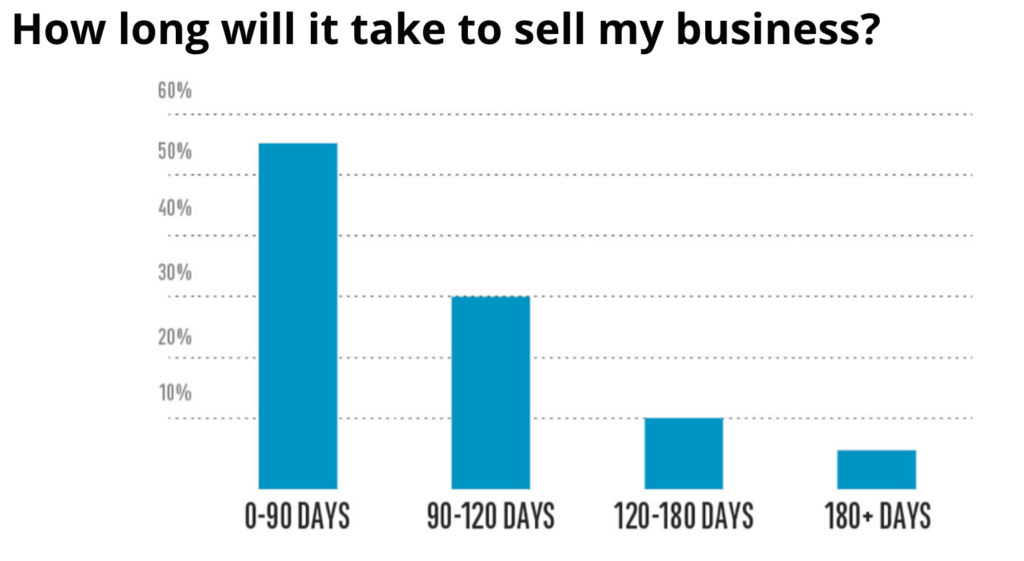
If you decide to sell impulsively, you might regret it down the road. In doing so, it’s unlikely that you’ll get maximum value for the company. How much more could you have made from the deal if you waited another six months? The answer could haunt you.
Not Getting Paid in Full and Up Front
Don’t accept an offer if you’re not getting paid upfront.
Someone could offer you double the listing price, but $0 today. Don’t assume that you’ll be paid in full with an installment plan over the next decade. So many things could prevent you from getting your money.
Let the new owner get their financing elsewhere. So when the sale is complete, the money is transferred directly to your account, in full.
Not Planning Early
Ideally, you’ve always had an exit strategy from day one. Failure to plan early could put you in a precarious position where you’re forced to sell.
I’ve seen some ecommerce websites scale too quickly to the point where the owner can’t handle the surge. What if your customer service inquiries go from five per week to 50 per day?
You need a contingency plan for every possible scenario.
If your goal from day one has always been to sell the website, that’s great. But who will you sell it to? At what point will you sell it? How will you sell it? Answering these questions ahead of time will make your life much easier when it’s time to go through with the sale.
Conclusion
The ecommerce industry is booming.
Thousands of people out there are interested in getting involved in the space. Buying an existing ecommerce website instead of building one from scratch is appealing to entrepreneurs.
Selling your ecommerce business can be extremely lucrative if you act accordingly. Just follow the step-by-step process that I’ve outlined in this guide to ensure you get the best possible price for your ecommerce site.
Find the Best Brokers
There are hundreds of business brokers in the USA! Find out which one is the best match for your specific needs. Enter your zip code below to begin.
from Quick Sprout https://ift.tt/2ZM4peI
via IFTTT
No comments:
Post a Comment